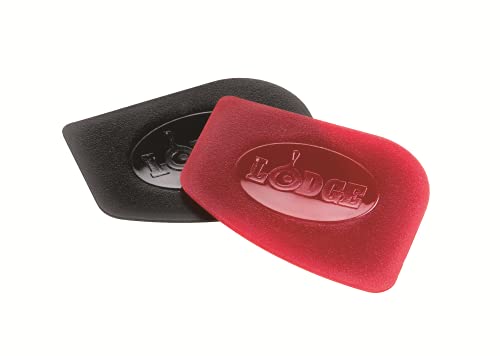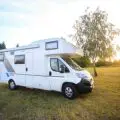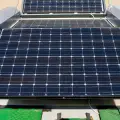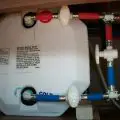Hey! This site is reader-supported and we earn commissions if you purchase products from retailers after clicking on a link from our site.
Campfires are a camping tradition. Many folks build a roaring fire to enjoy before turning in for the night. But hikers and backpackers know that campfires are much more than evening entertainment; they’re the stove, oven, grill, and heater too. So the next time you’re out enjoying the great outdoors, consider making your dinner on the campfire too.
To do so, you’ll need a simple campfire cooking kit. Of course, you could purchase a complete campfire cook set online. But you may already own some of the things you need. Here’s a look at the must-have campfire cooking supplies you should have to make an event out of your evening meal.
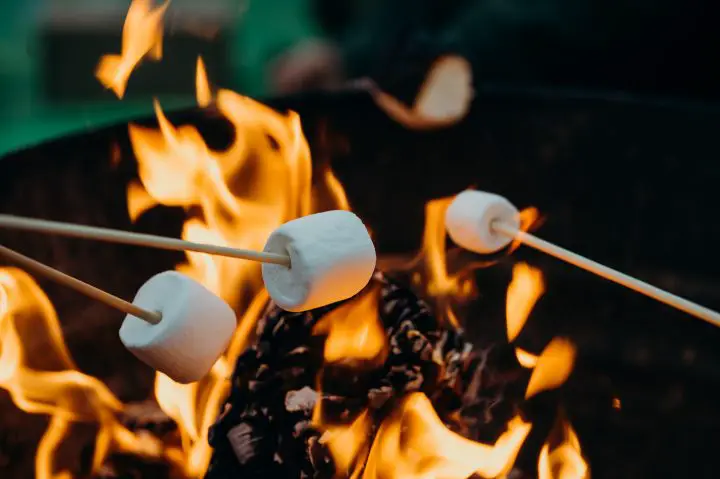
How Do You Cook Over a Campfire?
Cooking over an open fire is the oldest form of cooking there. In some ways, that makes it one of the simplest, but once you’ve done it a few times, you’ll realize there’s a lot to consider.
First, building a fire isn’t always that easy. And once you get the fire going, keeping it controlled enough to cook over isn’t easy.
Like all cooking and grilling, how enjoyable your campfire cooking experience is will depend on how prepared you are. Think through the steps and recipes, making sure you’ve got the right pots and pans and a place to sit them near the fire.
Most RVers dabble in campfire cooking here and there, but ultimately opt to cook on their RV grill or in the kitchen for simplicity’s sake. That’s a shame because campfire cooking is a lot of fun with the right tools.
Ways to Cook on a Campfire
Your campfire cooking kit will depend greatly on exactly how you want to cook and what you want to cook. It also depends on how you’re getting to the fire. Someone looking for a meal after a full day of backpacking in the wilderness will not have the same access to resources as someone sitting right outside their fifth wheel.
Flame Broil vs Grill and Griddle
If you put your food directly over the flames, you are flame broiling it. Instead, imagine a cut of meat rotating on a spit above the fire. This is the essence of campfire cooking. If you are cooking something large, like a roast, pork shoulder, or a wooly mammoth shoulder, you would want to roast it on a spit. This way, the meat can be turned as it cooks so that it is evenly cooked on the outside.
A grill grate simulates this by allowing the fire to get to the food, but the food is supported by a grate. This works just like a grill in your backyard, except that you’ll move the position of the grate to control its temperature. Juices will drain off through the grate and onto the fire, which will cause flareups but also adds some good flavor!
On the other hand, a griddle is a solid surface that can be heated by the fire below. A griddle is even more versatile since you won’t lose small objects or liquids through the grates. Griddles are perfect for delicate items, like flaky fish, or loose items, like asparagus. And, of course, griddles are required for the ultimate camp breakfast, pancakes.
Direct vs. Indirect Heat
Like grilling, to master campfire cooking, you must master indirect cooking. Since most campfires do not come with temperature knobs, the only way to get any control is to move your cooking space around based on temperature zones.
Since open fires have nothing to trap the heat in, it dissipates rather quickly as you move away. You can cook at any temperature by moving your spit or grate away from the center of the fire. Directly over the flames will be the hottest and is the perfect place for searing steaks or other fast-cooking items. But you must be careful, as most things burn before they get cooked.
By moving aside just a little bit, you can get plenty of heat without the scorching burn. Think of it as your own preheated 350-degree oven. This is the perfect spot to cook since it will allow items to cook in a controlled manner without burning. If you want that crusty flame-broiled sear, finish the meal for a few seconds to a minute in the intense inner flame to get it perfect.
Spit Roasting
Spit roasting combines direct and indirect heat in a controlled manner. You locate the spit so that the meal is rotating half over the fire and a half away from it. That way, as it rotates, it will gradually heat up and cook through. But, if you’ve timed it right, it will also build up a lovely flame-broiled crust evenly over its entire surface.
You can simulate spit roasting on a small scale, which is a lot easier and more practical if you are traveling as a couple or small group. The key is to use kabob skewers. Kababs are, after all, just tiny rotisseries. You can set them on a grill grate or rocks and turn them regularly with tongs. Skewers work best when everything on them cooks at the same speed.
Braising
Braising is cooking something in a flavorful liquid, which is what the Dutch oven is all about. Stews are the classic example, but you can braise pretty much anything. The liquid absorbs some heat and insulates the meat inside, all while absorbing flavor and helping break it down. The results are usually tender and delicious.
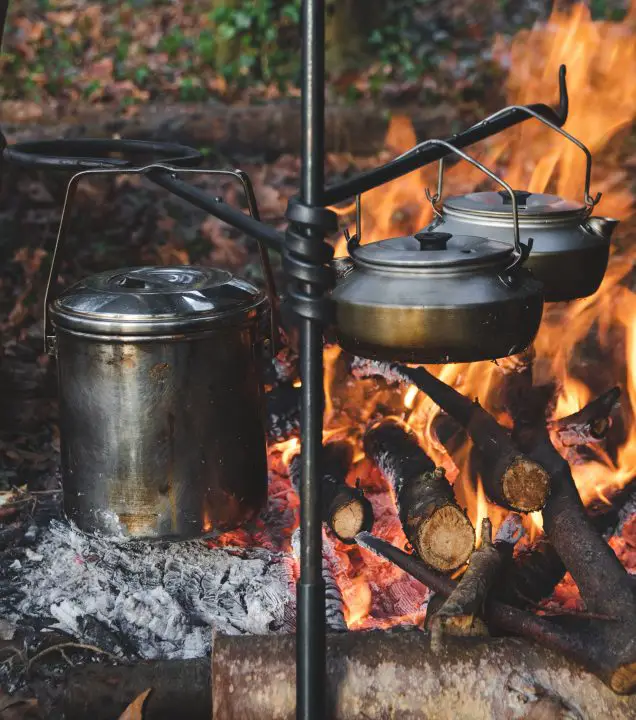
What Can You Cook on a Campfire? Camping Trip Food Ideas
As you might have guessed from the way to cook over a campfire, there are many dishes that you can cook over it as well. So there’s no reason to feel constrained to cowboy camp food.
Here are just a few campfire cooking ideas. The internet is full of great camp recipes. Looking for more inspiration? Country Living has a great list of more than 30 easy camping recipes.
- Classics: burgers, hot dogs, steaks, fish
- Breakfast skillets
- Kabobs (any meat or veggie)
- Chili
- Beer cheese dip or spicy queso
- Fajitas
- Grilled summer sweet corn
- Beer brats
- Pancakes
- French toast
- Cornbread
- Mixed meats and vegetables in foil packets
- Skillet cobblers
- Dutch oven-baked bread
- Popcorn
- Smores
What Do You Need to Cook Over a Campfire? Build Your Own Campfire Cook Set
Here’s a look at the basic items you’ll want to collect for a campfire cookware set. If you’re living in an RV or camper, many of these things you might already keep on board. The trick is to know what you need for campfire cooking in advance, so you can organize your tools and be ready to go.
- Firestarters
- Pots and pans
- Support or stand for pot
- Burn-proof gloves or pot holders
- Cooking utensils
- Mess Kit
Firestarters
It’s easy to get excited about your cookout and overlook one important factor, getting the fire started! They make it look so easy in the movies, but getting the job done in real life can be a task and a half.
First, you’ll need firewood. In many protected areas, it may be illegal to collect wood and you might need to bring your own or purchase it at a camp store. Everywhere else, a hatchet or saw will come in handy. The more even you can get your wood pieces, the easier it is to control the size and temperature of your campfire.
You might also want to carry some firestarters with you. These are sold at any big box store in the grilling section and they make starting a fire so much easier. And, of course, you’ll want to have a grill lighter and maybe some matches as a backup.
Pots and Pans
Now that you’ve got your fire built and warming up, it’s time to consider what you’ll cook the food in. There are two considerations when picking the pots and pans you should use over an open fire. One is purely aesthetics, while the other has serious repercussions on the outcome of your supper.
First, fires are dirty. Expect the pots to get soot and scorch marks; whatever you put over the fire is going to get nasty. If you use your favorite pots from home, they may never recover. At the very least, they’ll require some serious soaking and scrubbing.
Secondly, and even more importantly, heat control over an open fire is difficult. Thin pots will heat very quickly and unevenly. The thinner your cookware, the easier it is to scorch your food and burn things.
This is why cast iron is the best camp cookware. It already looks like it has been in the fire, so a little extra soot or scorch marks will only add to its character. And cast iron is one of the best materials to distribute heat evenly, so they help retain heat and provides a more predictable cooking experience.
Many people use other types of pans with good luck. Most hikers will choose ultra-lightweight aluminum camping dishes. These nest into small packages and weigh next to nothing for backpacking. They’re functional, but far from ideal when it comes to cooking. Since we’re based in RVs or vans and cooking near our car, cast-iron makes more sense.
The shape and size of your pans are entirely up to you. The most versatile is a large pot, like a Dutch oven. With something like that, you can boil water, cook stews, or use the bottom as a skillet for steaks, fish, or burgers. With a lid, you can even use it to bake bread or roast a whole chicken.
Of course, it’s hard to cook entire meals with just one cooking pot. A skillet is a nice addition, as are a small saucepan and a kettle to boil water. Some people like a reversible griddle/grill instead of the skillet, especially if you’re cooking for a big group. With these four items, you would likely be able to solve any cooking problem that springs up.
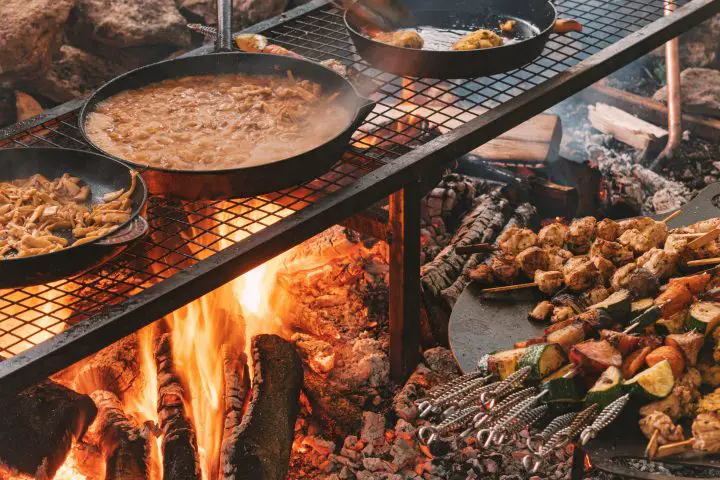
Supports and Stands for Open Flame Cooking
Just having the pots and pans isn’t enough, of course. These items need to levitate themselves over the fire at just the right height. Cast iron could theoretically be put right into the fire, but controlling the heat so your meal doesn’t burn will become very difficult. It will also be hard to get the food out once the pot is engulfed in flames.
There are two ways to support pots and pans. Just remember, if you’re using cast iron, make sure the stand is sturdy enough to support so much weight!
The first way to support a pot, and anything else, is with a grill shelf. These may be built from aluminum, steel, or cast iron, and they come in various shapes and sizes. You can easily find one to suit your cookware and style of cooking.
Some grates are designed to sit over the fire using the edges of a fire pit or ring. These are common in campgrounds, but if you are boondocking, it might not work so well. To save yourself from hunting for just the right height rocks, look for one with folding legs that will stand on its own.
Another solution is the swiveling cooking shelf. These are nifty in that they usually have several cooking areas and many options depending on the meal. They stand on their own with a stake driven into the ground. Then, various shelves, grates, and hooks swing your cooking items over the fire.
Alternatively, you could go full caveman-cowboy and hang your pots over the fire. The advantage of hanging is that you can often find branches or tree limbs that will work. But, you must add some chains and hooks that will hold your pots.
You can purchase cast iron tripods built to support big Dutch ovens. You can also find brackets holding three sticks together for backpackers, making a sturdy tripod. A chain then holds your pot over the fire.
A fancier version of the tripod will accommodate a spit for fire roasting rotisserie-style. This requires a bigger stand, but if you’re cooking a large meal for a big group, it gets the party started quickly.
Burn-Proof Gloves or Pot Holders
All of this handling of pots and pans near an open fire can be dangerous. Not only do you want some protection when you’re reaching in to lift the lid or turn the steak, but you also want protection after the pots come out of the fire. This is because cast iron stays hot long after it leaves the fire.
It’s never a bad idea to have a first aid kit handy, just in case!
Cooking Utensils
Long-handle grilling utensils are really handy. The most is a pair of extra-long-handled tongs. They should be sturdy enough to lift the heaviest lid you’ve got (likely the one on your cast iron Dutch oven). They should also not have any plastic or flammable parts. Even oven-proof silicone has limits, which you’ll likely find if you’re playing with an open fire. You may want to use them to adjust hot coals around your pot.
A long spatula is also handy, especially if you want to cook fish, pancakes, or burgers. But, again, opt for an extra-sturdy one that has no plastic.
There are all sorts of other cool campfire cooking tools you might want to consider as well. For example, you can get baskets on long handles that you can hold over the fire to boil your food. You can cook pretty much anything in the basket, from burger patties to vegetables.
You can also find telescoping forks that you can use to hold hot dogs or marshmallows for smores. These are fun for the kids and are pretty handy even if you don’t like smores. But who doesn’t like smores?
Similarly, metal skewers for kabobs come in handy in all sorts of situations.
Finally, no campfire kit is complete without a good supply of heavy-duty aluminum foil. Wrapping food in foil is a great way to seal in the juices and help it steam. This works especially well with things like potatoes, which would otherwise dry out and char if left near the fire too long.
Mess Kit
You’ve finished the cooking, and now it’s time to eat! A camping mess kit is your stash of plates, bowls, cups, knives, forks, and spoons. Hikers carry their own, and they are usually minimalistic. For example, instead of having a full cutlery set, they may have a single spork with a serrated knife on the edge. Instead of bowls and plates, they might just have one large shallow bowl and a metal drinking cup.
Your mess kit can be as basic or as fancy as you like. If you are at a drive-in campsite and have all the rest of your gear, there’s no reason not just to use the stuff you regularly do in your camper. On the other hand, if you’re hiking in, you probably will want something basic.
Sidebar – Care and Cleaning of Cast Iron Cookware
For all its wonder and utility, cast iron is one of the more fickle cooking materials. If you aren’t careful, cast iron can rust readily, leaving a nasty taste in your mouth. Thankfully, with a little prep and the right cleaning techniques, cast iron is easy to use and one of the best non-stick cooking surfaces.
The key to cast iron is seasoning. Not the salt on the food, but the oil on the pan. You must seal cast iron from water to not rust, and the process of baking on a thin layer of oil is called seasoning the pan. Most pans come seasoned, but throughout the life of your cast iron, you’ll wind up reseasoning it a few times a year.
There are lots of ways to season the pan. Always start with a clean pan and scrub off all the rust and discoloration. The easiest is to season it is to coat it with oil and then bake the pan in a hot oven. You can also season it over a flame, working to keep the oil spread evenly.
Once seasoned, keeping that oil on the cast iron is key. Avoid using too much soap when washing it because this will take off the oil. As you use the pan more and more, more oil will bake on, making the seasoning work even better. Using a scraper, water, and some elbow grease, it is possible to get all the food residue out without taking off the seasoning.
Never leave the pan wet as this will surely cause rust. The best way to dry the pan completely is to return it to the fire and let all the water boil off.
Every once in a while, something sticks, burns, or makes a general mess. The best course of action is to clean the pan thoroughly with soap and water and then reseason it.
Best Campfire Cooking Kits – Pots and Pans
| Image | Title | Price | Prime | Buy |
|---|---|---|---|---|
 | Lodge Cast Iron Cook-It-All Kit. Five-Piece Cast Iron Set includes a Reversible Grill/Griddle 14 Inch, 6.8 Quart Bottom/Wok, Two Heavy Duty Handles, and a Tips & Tricks Booklet. | PrimeEligible | Buy Now | |
 | Stanley Even Heat Camp Pro Cookset, 11-Piece Camping Cookware Set with Stainless Steel Pots and Pans, Utensils, Lids, and Cooking Accessories, Outdoor Travel Kit for Backpacking, Hiking, and Fishing | PrimeEligible | Buy Now | |
 | Lodge Pre-Seasoned Cast Iron 5 Piece Set, Black & Seasoned Cast Iron Care Kit 5-Piece Set, One Size, Assorted | PrimeEligible | Buy Now | |
 | Stanley Base Camp Cook Set for 4 | 21 Pcs Nesting Cookware Made from Stainless Steel & BPA Free Material | Incl Pot, lid, Cutting Board, Spatula, Plates, Spoons, Forks, Bowls, Dish Rack, Trivet | PrimeEligible | Buy Now | |
 | G4Free 13PCS Camping Cookware Mess Kit Campfire Kettle Outdoor Hiking Backpacking Picnic Cooking Pot Pan Bowl, Mini Stove, Stainless Steel Cup, Knife Spoon Set | PrimeEligible | Buy Now | |
 | Boundless Voyage Titanium Military Canteen Cups Set Outdoor Camping Hiking Water Bottle Bowl Cooking Set Mess Kit (Ti15158B (Canteen+2cups set)) | PrimeEligible | Buy Now | |
 | Lodge Deep Camp Dutch Oven, 8 Quart | PrimeEligible | Buy Now | |
 | Lodge 3 Quart Cast Iron Deep Skillet with Lid. Covered Cast Iron Skillet for Deep Frying and and Bread Baking. | PrimeEligible | Buy Now | |
 | Camp Chef Reversible Pre-Seasoned Cast Iron Griddle, Cooking Surface 14 in. x 16 | PrimeEligible | Buy Now |
Lodge Cook-It-All – Cast Iron Open Fire Cooking Equipment
This Lodge-made set is a superb starter set if you’re looking for the absolute best campfire cooking kit. It has everything you need and nothing you don’t, and it’s just the right size and shape for everyday use, campfire treats, and your next camping trip.
The base of the set is a 6.8-quart wok-style pot. It has an integrated stand that will hold it above the coals if you put it right in the fire. The lid for the pot is a 14-inch-round reversible griddle and grill pan. To round out the set, you get two wire handles that fit both the pot bottom and the griddle pan.
The great thing about this set is just how versatile the pieces are. You can cook veggies in the pot and steaks on the grill on top of it. You can invert it and use the griddle as a pizza stone, putting hot coals on top of the pot and using it as the top of your mini pizza oven. The possibilities are nearly endless.
- COOK-IT-ALL. This unbeatable set includes a 14-inch Cast Iron Grill/Grittle, a 6. 8-quart Wok/Skillet, two heavy duty handles for maneuverability and heat safety, and a 33-page tips & tricks booklet
Prices pulled from the Amazon Product Advertising API on:
Product prices and availability are accurate as of the date/time indicated and are subject to change. Any price and availability information displayed on [relevant Amazon Site(s), as applicable] at the time of purchase will apply to the purchase of this product.
Stanley Even-Heat Camp Pro Cookset
Stanley makes a few great camping sets, but the Even-Heat Pro set is nice because it has much higher-quality pots. They bridge the gap between the ultra-light aluminum sets used by backpackers and campers with the heavy-duty cast iron sets you might use as a purist.
The Even-Heat set is made of stainless steel, and the pots have encapsulated multi-layered bottoms for even heating. This 11-piece kit includes the following items.
- 4.75-quart stock pot
- 1.9-quart saucepan
- 8.5-inch frying pan
- Two strainer lids
- Cutting board
- Spatula
- Spoon
- Trivets
- Bungee to keep it all together
If there’s one problem with the Even-Heat set, it’s that it looks too good to put into a dirty fire!
- CAMP LIKE A PRO: Everything you need to whip up a hearty meal This 11-piece camping cookware set includes a 4 75qt stock pot, 1 9qt saucepan, 8 5” frying pan, vented lids, collapsible cutting board, spatula, spoon, two trivets, and locking bungee
Prices pulled from the Amazon Product Advertising API on:
Product prices and availability are accurate as of the date/time indicated and are subject to change. Any price and availability information displayed on [relevant Amazon Site(s), as applicable] at the time of purchase will apply to the purchase of this product.
Lodge Cast Iron Pans Complete Cookware Starter Kit
The Lodge starter kit is a good option if you want to start your cast iron collection from zero. You’ll get a variety of pots and pans, plus some handy tools that make cast iron ownership a snap.
This five-piece campfire cooking set comes with the following Lodge items.
- 10.25-inch griddle
- 8-inch skillet
- 10.25-inch skillet
- 5-quart Dutch oven
- Cast iron cover that fits the larger skillet and Dutch oven
In addition, this set includes the Lodge care package.
- Seasoning spray
- Pan scraper
- Silicone handle for skillets (up to 500 degrees – not for campfire use!)
- Scrub brush
- Cast iron use and care booklet
- Product 1: One Lodge Pre-Seasoned Cast Iron 5 Piece Set
Prices pulled from the Amazon Product Advertising API on:
Product prices and availability are accurate as of the date/time indicated and are subject to change. Any price and availability information displayed on [relevant Amazon Site(s), as applicable] at the time of purchase will apply to the purchase of this product.
Stanley Base Camp Cooking Equipment for 4
The Base Camp is a 21-piece camping set made for a family of four. The pots are thin and made from stainless steel–not the best for campfire use, but practical in that you get a lot of cooking options complete in this kit. You’d probably have a pretty good setup if you pair the kit with a solid cast iron dutch oven.
This set not only includes a 3.5-liter pot and a 7-inch frying pan, but it also includes sporks, plates, bowls, and four deep-dish plates. That makes it not only a campfire cooking set but a camp mess kit as well.
- 21 NESTED COMPONENTS: (1) 3 5L pot, vented lid, (1) 7 3-ply frying pan, (1) cutting board, (1) spatula, (1) serving spoon, (4) 6 plates, (4) 22oz bowls, (4) sporks, (1) dish drying rack, (1) heat resistant trivet, (1) locking bungee
Prices pulled from the Amazon Product Advertising API on:
Product prices and availability are accurate as of the date/time indicated and are subject to change. Any price and availability information displayed on [relevant Amazon Site(s), as applicable] at the time of purchase will apply to the purchase of this product.
G4Free Camping Cookware Mess Kit
Here’s the perfect mess and cooking kit for hikers and backpackers. But it’s also very practical if you have a teardrop camper or are just looking for a minimalist cooking option that will work in various situations.
The G4Free set includes not only the perfect assortment of small and lightweight pots and pans but also a mess kit for eating. And the folding silverware is a welcome change from cheap plastic sporks.
Included in this 13-piece set are the following items.
- 1.9-liter pot with lid
- 0.86-liter frying pan/skillet
- Kettle
- Two stainless steel drinking cups
- Folding knife, folk, and spoon
- Wood spatula
- Dish cleaning sponge
- Carabiner for clipping to your pack
- Two mesh storage bags
For campfire cooking, this set is far from ideal. The plastic-coated handles on the pot and pan will need to be kept far away from the direct heat of the fire. Additionally, the pots are thin and will heat very rapidly. They’re ideal for use on a camp stove, but on the fire, you’ll need to use a lot of caution.
- All in one, all things can be stacked together, this 13 pcs mess kit camping cookware set includes 1 camping pot with lid, 1 frying pan, 1 tea kettle, 2 stainless steel cups (4 oz), 1 utensil set (foldable fork, knife, and spoon), 1 cleaning sponge, 1 wooden spatula, 1 carabiner, and 2 mesh storage bag. You can watch the video below for detailed stacking and storage tutorials.
Prices pulled from the Amazon Product Advertising API on:
Product prices and availability are accurate as of the date/time indicated and are subject to change. Any price and availability information displayed on [relevant Amazon Site(s), as applicable] at the time of purchase will apply to the purchase of this product.
Boundless Voyage Titanium Canteen Mess Kit
Solo travelers might like an option that can be used anywhere at any time. This military-grade titanium survival set folds down and stacks very small but still provides great cooking options. You aren’t grilling a steak on it, but you can heat food or boil water.
The canteen is the perfect size and shape for carrying. It comes with a camouflage-colored carrying case with MOLLE straps for connecting to a pack or your belt.
In addition to the 37.2-ounce wide-mouth canteen, you also get a 25.3-ounce and 13.5-ounce pan that nest with the canteen. A vented lid fits both pots, and a wire for hanging the pots over a fire is also included. The pots–or cups, depending on how you use them–have folding handles.
Titanium is a high-tech metal used in aircraft and ship manufacturing. It’s expensive but also nearly indestructible. It does not rust or corrode and is much stronger than steel for its weight.
- Capacity: 37.2 + 25.3 + 13.5 fl oz, (1100ml + 750ml + 400ml). | Weight: 5.6 + 3.7 + 2.7 oz, (160g + 107g + 78g). | Total: 576grams/20.3ounces (including the carrying pouch and lid).
Prices pulled from the Amazon Product Advertising API on:
Product prices and availability are accurate as of the date/time indicated and are subject to change. Any price and availability information displayed on [relevant Amazon Site(s), as applicable] at the time of purchase will apply to the purchase of this product.
Lodge Campfire Pot 8-Quart
Just want a cowboy-style Dutch oven? This huge eight-quart Dutch oven includes a wire handle for hanging and tall integrated legs for standing close to coals. In addition, it includes a heavy, rimmed lid that can be stacked with coals for all-around heating.
It’s also available in two, four, or five-quart sizes. This one comes with a Dutch Oven Cooking 101 handbook, as well. The eight-quart version weighs 20 pounds. It’s big enough to cook for a group, and the bail-style handle is perfect for slow cooking while hanging from a sturdy tripod.
- 8 QT. DEEP CAMP DUTCH OVEN. The Lodge portable “camp stove” is the pot that does it all. The flanged lid holds hot coals and inverts for use as a griddle. The integral legs allow the oven to sit perfectly over the campfire.
Prices pulled from the Amazon Product Advertising API on:
Product prices and availability are accurate as of the date/time indicated and are subject to change. Any price and availability information displayed on [relevant Amazon Site(s), as applicable] at the time of purchase will apply to the purchase of this product.
Lodge 3-Quart Deep Skillet with Lid
Here’s a smaller option from Lodge that could work as your one and only solution. It’s a deep cast-iron skillet with a close-fitting lid. That means it could serve you as either a skillet or frying pan, but it’s also deep enough to serve as a make-shift Dutch oven. This is worth a close look if you only have room in your camper or budget for one Lodge item.
- 10.25” (3.2 Quart) Cast Iron Deep Skillet with Cover
Prices pulled from the Amazon Product Advertising API on:
Product prices and availability are accurate as of the date/time indicated and are subject to change. Any price and availability information displayed on [relevant Amazon Site(s), as applicable] at the time of purchase will apply to the purchase of this product.
Camp Chef Reversible Griddle
A reversible griddle is a good option for all-around cooking over camp grills and campfires. This gives you some versatility when it comes to grilling veggies or smaller items, plus it gives you the griddle for eggs and pancakes the next morning.
This one is made by Camp Chef, Lodge’s main competitor. It’s heavy-duty cast iron and measures 14 by 16 inches. It’s made to fit the Camp Chef camping kitchen, but it could easily suit campfire use.
- Double-sided grill/griddle combo lets you griddle breakfast, then flip it over and grill dinner
Prices pulled from the Amazon Product Advertising API on:
Product prices and availability are accurate as of the date/time indicated and are subject to change. Any price and availability information displayed on [relevant Amazon Site(s), as applicable] at the time of purchase will apply to the purchase of this product.
Campfire Cooking Supplies and Other Camping Gear
| Image | Title | Price | Prime | Buy |
|---|---|---|---|---|
 | GrillPro 40269 20-Inch Professional Extra Long Tong,Silver | PrimeEligible | Buy Now | |
 | Lodge 14.5” Leather Outdoor Cooking Gloves - Heat Resistant Gloves for Cast Iron Cooking | PrimeEligible | Buy Now | |
 | Texsport Heavy Duty Camp 24" X 16" Grill | PrimeEligible | Buy Now | |
 | Texsport Heavy Duty Barbecue Swivel Grill for Outdoor BBQ over Open Fire | PrimeEligible | Buy Now | |
 | Lodge Pan Scrapers. Handheld Polycarbonate Cast Iron Pan Cleaners. (2-Pack. Red/Black) | PrimeEligible | Buy Now | |
 | MalloMe Marshmallow Roasting Sticks - Smores Skewers for Fire Pit Kit - Hot Dog Camping Accessories Campfire Marshmellow 32 Inch Long Fork - 5 Pack | PrimeEligible | Buy Now | |
 | Metal Skewers for Grilling,Kabob Skewers,Flat BBQ Barbecue Skewer,Grilling Skewers Set,Reusable BBQ (14" skewers(16 pack)) | PrimeEligible | Buy Now | |
 | Stansport Deluxe Cooking Broiler (339) | PrimeEligible | Buy Now |
Extra-Long Grill Tongs
Nothing is more important for camp cooking than really good tongs. You’ll use your tongs for tending the fire, flipping the steaks, and lifting lids on heavy cast iron pots.
These GrillPro tongs are strong enough for the job and don’t have any plastic to melt in the fire. They come in 15, 16, and 20-inch versions, but the longer, the better for campfire cooking.
- Stainless steel professional extra long tong
Prices pulled from the Amazon Product Advertising API on:
Product prices and availability are accurate as of the date/time indicated and are subject to change. Any price and availability information displayed on [relevant Amazon Site(s), as applicable] at the time of purchase will apply to the purchase of this product.
Lodge Campfire Cooking Gloves
A sturdy pair of heat-resistant gloves is a must-have for campfire cooking. You will inevitably need to move something or lift something at a bad time, and you can’t always get the right angle to lift with a pot holder or your tongs safely. Gloves mean you can grab cast iron pots and pans and move them around safely.
There are tons of welding or firefighter gloves on the market, so don’t feel you have to limit yourself to this pair by Lodge. But they are nice and long (14.5 inches) and made of beautiful brushed leather.
- LODGE LEATHER GLOVES (14. 5 ). The Lodge Gloves are made of brushed leather, fully lined, and sewn with durable leather welting on the finger seams. Great for protection from radiant heat when cooking over a grill or campfire
Prices pulled from the Amazon Product Advertising API on:
Product prices and availability are accurate as of the date/time indicated and are subject to change. Any price and availability information displayed on [relevant Amazon Site(s), as applicable] at the time of purchase will apply to the purchase of this product.
Over Fire Camp Grill
If you’re visiting a basic campground and want to cook over the fire, the first real problem will be finding a place to put your pots and pans over the fire.
The Texsport camp grill is a simple grate that fits over the fire. It’s robust enough to support several cast iron pots and skillets. The medium has a 16 by 12-inch grate, while the large has a 25 by 16-inch grate. Both stand six inches tall, but the legs fold down, so it’s only about one-inch thick for storage. It is a simple steel frame that is painted, and users report that the paint will burn off after the first use.
- For use with outdoor cookware, including heavy cast iron (not intended for direct-contact grilling)
Prices pulled from the Amazon Product Advertising API on:
Product prices and availability are accurate as of the date/time indicated and are subject to change. Any price and availability information displayed on [relevant Amazon Site(s), as applicable] at the time of purchase will apply to the purchase of this product.
Heavy-Duty Campfire Swivel Grate
If you want a little more utility, you might opt for a swivel grate like this. It stands on a 28-inch stake that you can put into the ground around the fire. Then you can control the height away from the flames and direct versus indirect cooking by swiveling the grate away. The grill surface measures 24 by 16 inches, plenty big for kettles, skillets, and even large griddles.
- Solid Metal Construction welded of high quality steel to go over an open campfire
Prices pulled from the Amazon Product Advertising API on:
Product prices and availability are accurate as of the date/time indicated and are subject to change. Any price and availability information displayed on [relevant Amazon Site(s), as applicable] at the time of purchase will apply to the purchase of this product.
Lodge Pot Scrapers
These Lodge-brand scrapers are perfect for cleaning all of your pots and pans. They have just the right combination of curved and flat surfaces to scrape out any shaped vessel. In addition, they’re made of heavy-duty polycarbonate plastic that won’t break. This is a two-pack that comes with a red and a black one.
- Pan Scrapers – Includes 1 Red and 1 Black Scraper
Prices pulled from the Amazon Product Advertising API on:
Product prices and availability are accurate as of the date/time indicated and are subject to change. Any price and availability information displayed on [relevant Amazon Site(s), as applicable] at the time of purchase will apply to the purchase of this product.
Telescoping Marshmellow Roasting Sticks
These telescopic forks are great fun for the whole family. But they can serve double duty since their long prongs can hold a variety of foods. They aren’t the most robust cooking implements in your kit, but they can be handy to toast bread over the fire or even cook a hot dog.
This is a five-pack, and each fork extends 32 inches long.
- ✅ BUILT TO LAST! Highest quality power welded forks use non-toxic 18/8 304 stainless steel to ensure easy cleaning, no rusting and safe roasting. Smooth finished wooden handles ensure a steady grip and no more hot handles.
Prices pulled from the Amazon Product Advertising API on:
Product prices and availability are accurate as of the date/time indicated and are subject to change. Any price and availability information displayed on [relevant Amazon Site(s), as applicable] at the time of purchase will apply to the purchase of this product.
Metal Kabob Skewers for Campfire Cooking
Kabob skewers are super handy when campfire cooking. You can use the standard pack of bamboo skewers from any supermarket or big box store, but a metal set like this is a little more convenient. For one, you won’t have to worry about soaking them, so they don’t burn.
This is a 16-pack of 14-inch skewers. They’re made of stainless steel and are food-grade and rust-proof. In addition, the flat-blade design means you don’t have to worry about the food spinning while cooking, an annoying problem with round bamboo skewers.
- 【PREMIUM STAINLESS STEEL, EXCELLENT WORKMANSHIP】The Metal skewers for Grilling are made of premium stainless steel which is food grade, rust proof and heat resistant. The heavy duty grill skewers are corrosion resistant and can last long. All edges around the metal skewers are well polished, making the barbecue skewers safe to use.
Prices pulled from the Amazon Product Advertising API on:
Product prices and availability are accurate as of the date/time indicated and are subject to change. Any price and availability information displayed on [relevant Amazon Site(s), as applicable] at the time of purchase will apply to the purchase of this product.
Campfire Cooker and Broiler
There is a wide variety of broilers like this one available from camping stores. These long-handled baskets allow you to grill all sorts of foods over the fire without any other equipment. They make a fun way to cook something small for the occasional camping trip or smores night. Generally, though, they are more about fun and quick reheating than making a whole meal.
This deluxe basket broiler has three areas and can be used to cook pretty much anything that fits in the basket. Fish, burgers, hot dogs, steaks, chicken, or even toast will work. It’s 24 inches long and 13.75 inches wide.
Another option for this type of cooking is the cast iron cookers mounted on long sticks. These are handy for individual campers who are cooking over a group fire. Coghlan sells a variety of these. The cast-iron cooking box is usually round for burgers or square for hot-pressed sandwiches.
Prices pulled from the Amazon Product Advertising API on:
Product prices and availability are accurate as of the date/time indicated and are subject to change. Any price and availability information displayed on [relevant Amazon Site(s), as applicable] at the time of purchase will apply to the purchase of this product.
Build You Own Campfire Cooking Kit and Get Cooking
Cooking over the campfire is a fun pastime, whether in a city campground at a fire ring or out in the boondocks with nothing by the stars. It’s primal and basic, but it can also be civilized and enjoyable. For RV life, campfire cooking can connect you with the outdoors and make an event out of meal time. So light a fire and enjoy!
FAQs (Frequently Asked Questions)
What do you need to cook over a campfire?
How you cook over a campfire depends greatly on where you are and what supplies you have. First, you need heavy-duty pots and pans, like a cast-iron Dutch oven. These will help distribute heat and hold up to the scorching heat better than most other pots and pans. You’ll also need a way to suspend the pot or pan, like a grilling grate over the fire or a campfire tripod pot holder.
What kind of pans do you use on a campfire?
The absolute best pans for campfire use are cast iron pots and skillets. These distribute heat well and stand up to extremely high temperatures.
What is the most popular campfire food?
The most popular campfire foods are camping staples like hot dogs, burgers, kabobs, or smores. But campfire cooking doesn’t need to be limited to well-known dishes. You can cook almost anything over an open fire with a little preparation, the right tools, and a little trial and error.
Can you use regular pans on a campfire?
You can use any pan on a campfire so long as it has no plastic components. Unfortunately, many regular pans have plastic handles. Even oven-safe plastics will melt over a campfire. You should also know that regular pans will likely come out of the fire covered in soot and scorch marks. Thinner pans can easily burn food. All of these reasons make cast iron the best material for campfire cooking.














